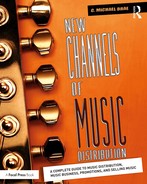Appendix 1
Radio Campaign Codes and Spreadsheet Sample
Why pay an expensive radio promoter when you can do it all yourself? Below are a few sample codes you can use to place in a radio campaign spreadsheet in tracking your radio promotional efforts.
Codes
- T = T his week, 2 = 2 weeks ago, 3 = 3 weeks ago, etc.
- L = L ast week
- - = No info on status of music yet
- * = We have info on the status of the music, but there is no change this week (that we know of) since we did not talk live to anyone.
- LM = Left Message, sent fax, or both
- G = Got MP3/digital version
- A = Added track or song to playlist (commercial radio); added track to library (non-commercial)
- L = Low rotation (commercial: 5–9/week; non-commercial: 4–6/week)
- M = Medium rotation (commercial: 10–19/week; non-commercial: 7–9/week)
- H = High rotation (commercial: 25+/week; non-commercial: 10+/week)
- S = Specialty show, or testing (commercial only)
- N = No plays
- D = D iscontinue calling this station.
- R = R esend digital track.
- P = Send a Pack for on-air giveaway: 5 digital tracks, 5 bios and 5 each of any of the other items available (posters, pictures, shirts, videos, tickets, etc.).
- I = Send ID; you will be faxed a separate detail sheet.
- V = Interview or Visit. Call number provided in comments column.
- No Contact = The music phone, business phone and studio phone of the station were all incapable of taking messages, and the fax did not go through. Emails, however, may have still gone through.
- Two codes in one column; for example, “PL” simply means what each individual code means.
- “Station Playlist #5” means the artist is the fifth most played at the station.
- “CMJ playlist #5” (non-commercial only) means that the playlist information from above made it into the CMJ magazine.

..................Content has been hidden....................
You can't read the all page of ebook, please click here login for view all page.
